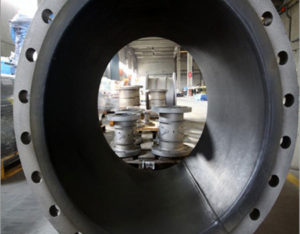 The longer tanks and piping store, transport, and mix caustic and abrasive materials, the more at risk they become for failures at the hands of corrosion and wear and tear. The majority of U.S. industrial facilities are more than 20 years old. This leaves many in need of equipment maintenance and, oftentimes, serious tank or piping repairs. Facility leaders working in various industries face similar statistics and require innovative solutions to keep their operations and tanks intact.
The longer tanks and piping store, transport, and mix caustic and abrasive materials, the more at risk they become for failures at the hands of corrosion and wear and tear. The majority of U.S. industrial facilities are more than 20 years old. This leaves many in need of equipment maintenance and, oftentimes, serious tank or piping repairs. Facility leaders working in various industries face similar statistics and require innovative solutions to keep their operations and tanks intact.
One common and cost effective solution operators can implement is installing corrosion resistant rubber linings in tanks and pipes. These liners offer excellent protection due to specialized compounding, making them extremely durable and applicable to a wide variety of uses. Rubber linings can withstand tough environments such as those found in chemical plants, power plants, steel mills, mines, and others. They help combat corrosive materials, including mineral slurry, acids, salt water, corrosive liquids, and fumes. Furthermore, rubber linings are key in sealing pipes and tanks for water or gas storage.
A variety of materials comprise rubber liners, which are made using different vulcanization techniques, each customized for specific situations and uses. Typical rubber lining options include the following:
- Soft natural is a good lining option for tanks holding most inorganic chemicals. Soft rubber’s corrosion resistant properties can withstand many abrasive materials. It is commonly used for hydrochloric acid applications. However, this type is not suited to handle any strong oxidizing agents.
- Semihard natural is very similar to soft natural rubber, but firmer. This characteristic makes it more durable and chemical resistant, enabling semihard natural rubber to better endure harsh environments. It is also very resistant to corrosion. Facility leaders often use this rubber type in their chemical storage tanks.
- Bromobutyl is best known for its ability to contain air, gas, and moisture. This synthetic rubber is very resistant to abrasive and caustic chemicals — including many acids — and is frequently used in tank linings. Bromobutyl also has good ozone and age resistance. This rubber can withstand temperatures of up to 260° Fahrenheit for most applications.
- Chlorobutyl is similar to Bromobutyl as it is also derived from butyl rubber. Chlorobutyl is “somewhat less reactive” than Bromobutyl and is often mixed with natural rubber for optimal adhesion. It is also suited to reduce the permeability of air, gases, and moisture.
- Neoprene is another popular synthetic rubber. It can tolerate higher temperatures than natural rubber and has greater longevity in those conditions. This rubber is known “to withstand petroleum-based mixtures, such as solvents, oils, and greases. Additionally, it can withstand methyl and ethyl alcohols as well as alkalines, mineral acids, and some salt solutions.”
- EPDM or ethylene propylene diene monomer rubber is best suited to resist “ozone and sunlight, oxidizing chemicals, non-flammable hydraulic fluids, pure aniline, fire extinguisher liquids, acids, hot water and steam,” according to the Piping Engineering article. It is versatile, making it a good choice for a variety of applications. However, it is not suited for petroleum based products.
- Nitrile rubber, on the other hand, is a petroleum resistant solution. While it can withstand temperatures up to 80 degrees Celsius, it can also operate at lower temperatures and is less ozone resistant than other rubbers. Nitrile rubber is stronger and more versatile than natural rubber.
Regardless of the rubber lining type best suited for your tanks and pipes, implementing rubber linings is a valuable investment. Operators find rubber linings to be especially beneficial because they require minimum maintenance and allow for less downtime by preventing failures, leaks, and other damage at the hands of corrosion and abrasion. To protect the integrity of your equipment and promote its longevity, it’s important you understand what rubber linings would work best for your specific facility, operations, and environment.
